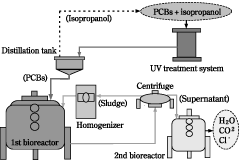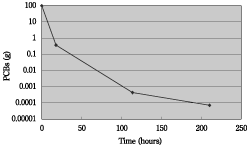
Fig.1 Schematic diagram of the pilot plant
Polychlorinated biphenyls (PCBs) are widespread environmental pollutants which are recalcitrant to biodegradation. After the effect of PCBs on human health was reported, the manufacture and use of PCBs were banned and large amounts were recovered and stored for subsequent detoxification. In railway technologies, PCBs were mainly used as the transformer oil in motor cars of Shinkansen and limited express trains. Incineration is the most common approach for disposal of PCBs. However, incomplete combustion of PCBs can result in the formation of polychlorinated dibenzo-p-dioxin and hence incineration is banned in Japan. Therefore, various alternative technologies, which can pass the standard of 3 mg/L (3 ppb) of PCB in effluent as demanded by law in Japan, are being explored. Microorganisms which can degrade PCBs have been discovered all over the world. Researches concerning PCB metabolism have been reported, but the limitation of biodegradation has also been pointed out. We have developed a method to combine physicochemical treatment with biological degradation for the complete degradation of concentrated PCBs. We examine a pilot plant study on the degradation of PCBs from high voltage transformers. After optimizing the culture conditions, we could eliminate over 99.9999 % of 100 g Kaneclor 1000, equivalent to Askarel Type D which consists of 70 % of Kaneclor 500 (equivalent to Aroclor 1254) and 30 % of trichlorobenzene, within nine days. This degradation rate is sufficient for the construction of an industrial degradation process for PCBs. Our method has been approved by the committee of the Ministry of International Trade and Industry and Ministry of Health and Welfare. The Ministry of Health and Welfare amended the "Waste Disposal and Public Cleaning Law" to include the RTRI method in the authorized PCB treatment system.

A low pressure mercury lamp was used as the source of ultraviolet (UV) irradiation. About 100 g of Kaneclor 500 was dissolved into 40 liters of 75 % isopropyl alcohol solution containing 10 L of water and 100 g of NaOH. The PCB mixture was irradiated with UV for about 18 hours at room temperature.
The UV-treated mixture was transferred to a distillation tank and distilled for about 12 hours. The concentrated PCB mixture was then put into 500 L of bacterial culture. A system with two bioreactor units was used in this treatment. Air was supplied at 200 L/min at the agitation rate of 80 rpm. The incubation was continued up to 96 hours at 30 üŗC.

After 18 hours of UV irradiation, over 99 % of PCBs were dechlorinated and biphenyl, mono- and di-chlorobiphenyls accumulated in the mixture.
The UV-irradiated PCBs were added to a 500 L culture at the initial concentration of about 1 mg/L and the concentration of PCBs decreased to less than 10 mg/L in 48 hours. Then 30 % of the first treatment culture was transferred to the 2nd bioreactor. The remaining 70 % of the culture in the first bioreactor was recycled in the next treatment. PCBs were degraded to less than 0.5 mg/L (quantitative limitation) in the 2nd bioreactor in two days. After optimizing the culture conditions, we could eliminate over 99.9999 % of 100 g Kaneclor 1000 within nine days.